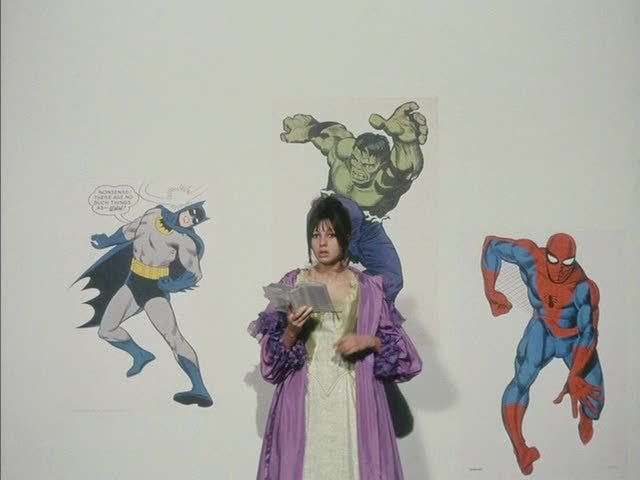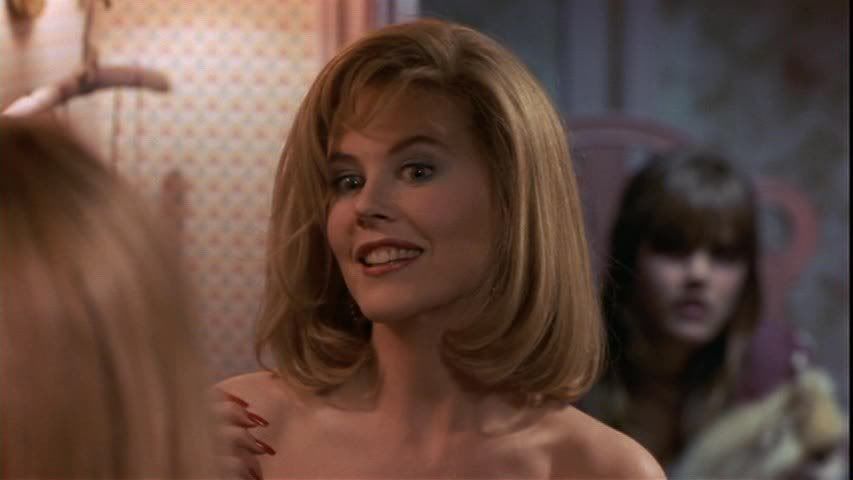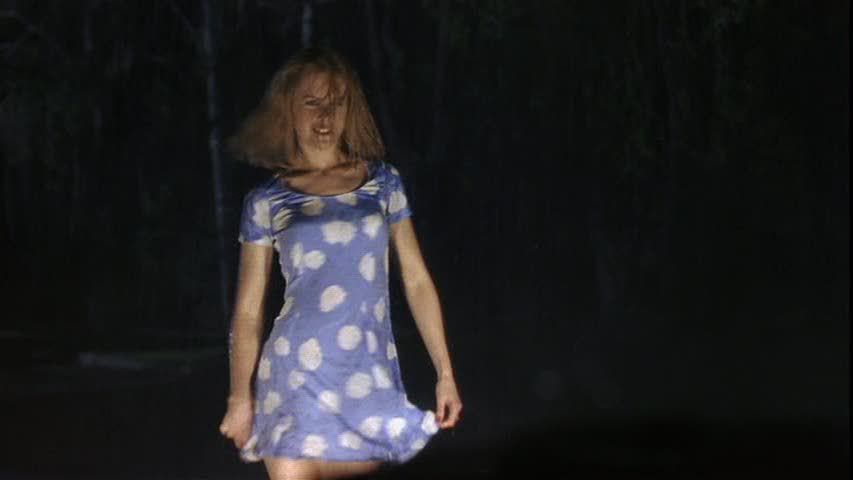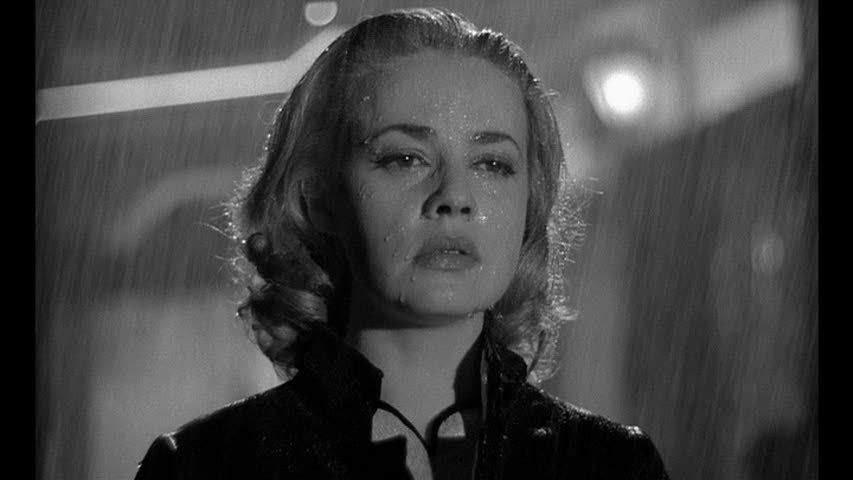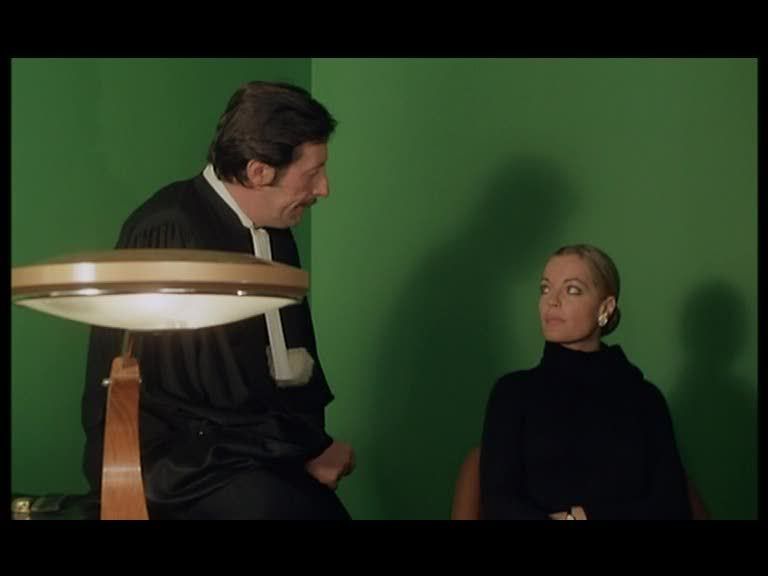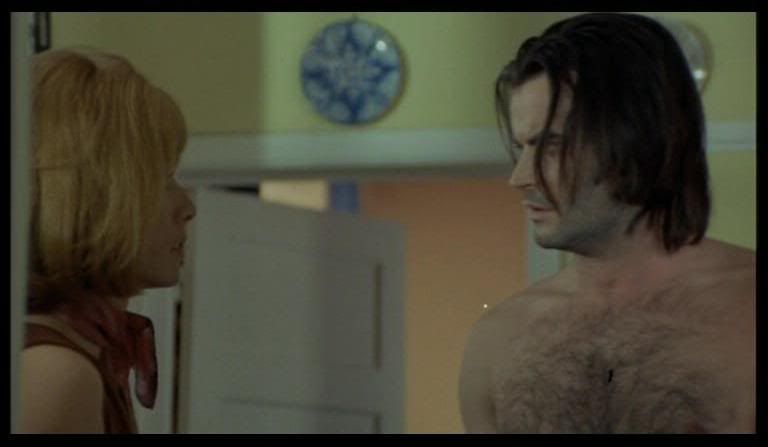
The title of Claude Chabrol's La rupture is a wonderfully slippery phrase for a wonderfully slippery movie. It refers, or seems to refer, to an incident that occurs, with shocking, sudden violence, within the first minute of the film. The struggling writer Charles (Jean-Claude Drouot), son of a rich bourgeoisie family, wakes up one morning, walks into the kitchen, and without saying a single word, brutally assaults his wife Hélène (Stéphane Audran) and their son, until Hélène finally manages to subdue him with a frying pan. As is typical of Chabrol, this scene sets the tone of the film right from the start. The first few moments of the film are quiet and peaceful, with Hélène cheerfully preparing for her day and feeding her son. The attack itself, coming so suddenly with virtually no set-up, is thus doubly startling and disorienting, creating a stark rupture in the fabric of the placid domesticity that existed before Charles — shirtless, hulking, wild-eyed — emerged from his room. This incident of violence, so frightening and abrupt, is the film's first sign of fault lines.
This attack does indeed hang over the rest of the film, and yet it is not the only rupture that occurs in the course of the film. The title could just as easily refer to Chabrol's aesthetic approach to this narrative of domestic fracturing, which might be described as a system of tiny ruptures in the narrative continuity and the cinematic conventions. Chabrol's characteristic editing can only be described as abrupt, jarring, even disorienting at times. His choices in editing and camera movement never fail to call attention to themselves, but they do so in ways that also subvert the usual psychoanalytical readings of camera movement and film techniques. His choices in constructing his film rarely reveal the emotional tenor of the scene, nor are they meant to suggest anything about the interior states of his characters, which are usually only as apparent as the characters themselves wish to make them. Rather, his editing in particular often seems to be governed by a utilitarian philosophy that has little patience for the niceties of continuity and spatial laws. Chabrol cuts directly from an interior shot in which Hélène says, "We'll take the tram," to a point-of-view shot out the front window of said tram, directed downwards at the rails speeding by below. Likewise, no sooner does Hélène say she is going to see her injured son than, in the very next shot, she is standing beside his bed, already in mid-motion as she leans down towards him. Such direct, sudden cuts frequently move Chabrol's characters from place to place, so much so that on the very rare occasion when he uses a dissolve to indicate a passage of time or place, it seems inappropriate, a lapse into a much more conventional cinematic vocabulary.
The film's other crucial "rupture" is in terms of point of view, which remains puzzlingly ambiguous throughout the film. Hélène is undoubtedly the story's protagonist at the outset, reacting to this brutal assault and to the remarkably hostile reaction that she receives from those around her, who seem to blame her for the events and for hurting her husband, rather than the other way around. But at some point, Chabrol subtly, sneakily diverts the audience's attention from this besieged woman, shifting the film's point of view onto Paul (Jean-Pierre Cassel), the shady character who's hired by Charles' rich father Régnier (Michel Bouquet) to discredit Hélène. At this point, the film becomes something of a low-key thriller, as Paul attempts to gather evidence to paint the saintly Hélène as a whore, a drunk, a drug addict, a child molester: anything in order to make her appear unfit to take care of her son. Chabrol completes this shift in perspective so smoothly, so quietly, that one barely even realizes at first that Hélène has been shuffled into the background, while Paul has taken over the place of the protagonist.
The audience is thus placed in a strange relationship with respect to Paul. He's a detestable character in so many ways, and furthermore attempting to smear and ruin a thoroughly good and sympathetic woman. And yet Chabrol realizes the sway that a strong central protagonist can have over audiences, with a potential to redeem or at least complicate the reception of even the sleaziest anti-hero. He allows Paul's charming and warm outward manner to seduce the audience even as it earns him the trust of Hélène herself. Nor is Paul entirely unsympathetic. In fact, he is a dark mirror of Hélène in terms of the film's emphasis on economics and class divisions. He is, like her, struggling on the edges of poverty, doing whatever it takes to make ends meet. Just as she once worked, briefly, as a stripper and now serves as a barmaid — both careers that automatically lowered her in the eyes of Charles' class-conscious parents — Paul is irrevocably lower class. Furthermore, there's a strong suggestion that Paul was himself a victim of the ruthless business practices of Régnier; his promised reward for his dirty work will be a well-paid managerial job, a chance to return to the rich man's business empire. Paul is placed in the kind of position that would normally be reserved for the hero of a spy thriller. The focus is on him, not Hélène, as he attempts to weave the traps and complicated plans that will undo her. It seems inevitable that he will succeed, that his schemes will go off without a hitch, just as they always do for the master spy trying to outwit his nemesis.
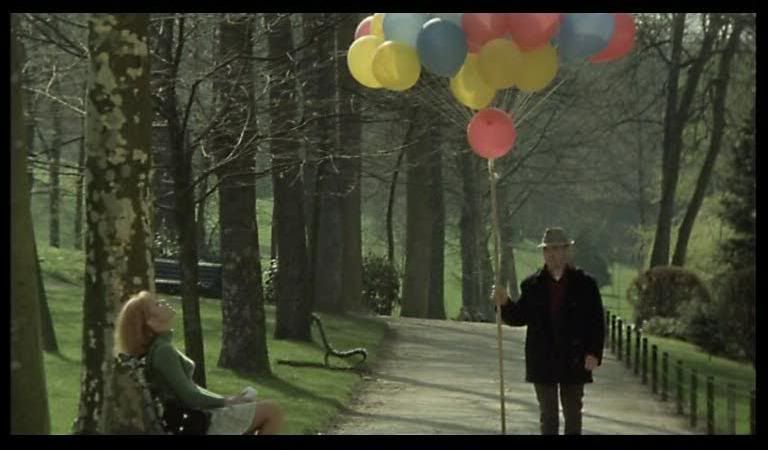
At this point, with Paul seemingly in complete control and ready to spring his devious trap, the film switches, in its final act, back to a point of view more closely aligned with Hélène, the original and true protagonist. Chabrol's feat here is to construct a series of illusions that are designed to fall apart completely once the point of view returns to Hélène. There's one last wonderful sequence, after Hélène coolly rejects Paul's dim-witted attempts to rope her into his convoluted scheme, when the crestfallen henchman scurries around, desperately trying to straighten up after the mess he's made, literally cramming the evidence of his endeavors into his closet. It's a complete deconstruction of the film's secondary protagonist, this slimy man who briefly seemed to be deviously clever but is revealed as insufficient to the task in the face of Hélène's calm, reserved goodness. It's also a gleeful subversion of the conventional thriller plotline, in which the hero or heroine is inevitably forced to do absolutely illogical things in order to comply with the dictates of the screenwriter. This film's heroine, refreshingly, reacts with intelligence and rightful suspicion, thereby completely disintegrating Paul's laughably absurd plot, which might itself have been scripted by a Hollywood genre scribe.
Paul's plot fails, then, because he is relying on a Hollywood-stupid adversary, but also because his deceitful evil can ultimately not measure up to the good in the world, and in Hélène. This goodness radiates from her throughout the film, as Audran delivers a stunning, restrained performance. This woman represents one half of the film's dissection of that essential myth of femininity, the Madonna/whore complex. She is a saintly creature, unshaken by tragedy, always ready to face each challenge with her seemingly unlimited reserves of strength. As she says towards the end of the film, spitting it like a curse at the increasingly unraveling Paul, "I am tired, but I still have my strength." It's a fitting line for a woman who is the embodiment of perseverance and constancy, an eternal mother figure willing to do anything to protect her child. If Hélène is the film's Madonna, its whore is undoubtedly Paul's girlfriend Emilie (Marguerite Cassan), a creature of such pure, unfiltered sexuality that she is naked or nearly naked in virtually every scene in which she appears. She is continually throwing herself at the disinterested Paul, who more and more seems simply bored with her unfettered sensuality, and perversely attracted to the untainted Hélène. Emilie is woman stripped, quite literally, of everything but a raw sexual drive. At one point, when Paul asks her what she's thinking, she simply smiles lasciviously, prompting his reply: "That's all you ever think about."
These are, of course, the two poles of conventional media representation for women, and Chabrol navigates the film's proto-feminist sentiments in typically interesting ways, drawing out the complexity and strength of Hélène's vision of womanhood. In fact, far from being the simplified "Madonna" figure, she is a fully fleshed-out woman, capable of great strength, great independence, mothering instincts, and even remarkable passion, as we finally see towards the film's end as the depth of her feelings for Charles are revealed in a scene of pure melodrama. Society is all too willing to slap a much simpler label on Hélène, tagging her as a whore for her past as a stripper or for her pending divorce. Society would much rather she was as easy to identify and classify as Emilie, who in fact is a pure cartoon, a hollowed-out male fantasy projection. The film's opposition of these two "types" is thus, not only a Madonna/whore dichotomy, but a contrast between a "real" woman, with all her attendant complexity, and a purely fictional construction intended to elicit sexual urges and nothing more. It's no coincidence that Paul's apartment, in addition to housing the perpetually naked Emilie, is papered with photos clipped from porno magazines; Emilie originates from the same source.
If the film mostly focuses on these central conflicts, particularly the tense and antagonistic relationship between Paul and Hélène, there is also a lot going on in the margins as well. Chabrol has crammed the film with a weird, quirky supporting cast, ranging from a morally censorious landlady (Annie Cordy) to a hammy actor with a much more expansive, humanistic view of morality (Mario David) to the trio of gossipy old women who, like a Greek chorus, comment on the action and come to life as avenging harpies or guardian angels in the film's hallucinogenic final section. La rupture is an unsettling masterpiece for Chabrol, a film that's at times shocking, at times darkly funny — especially during a ludicrous but satisfying denouement that needs to be seen to be believed — and always piercing in its satirical insights about class, gender, economics, and relationships.






